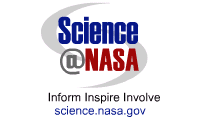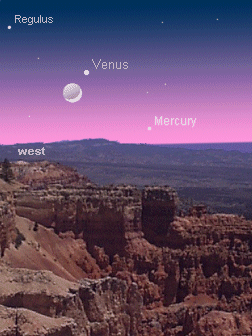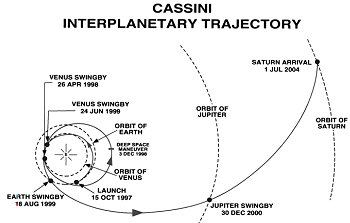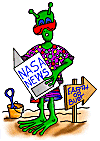 NASA Science News home |
|
 June 14, 1999: For the second time in less than a month
the planet Venus and the Moon are poised to put on a spectacular
show for stargazers.
June 14, 1999: For the second time in less than a month
the planet Venus and the Moon are poised to put on a spectacular
show for stargazers.
Last Friday, June 11, Venus reached its greatest apparent distance from the sun in 1999 (45o). For the rest of June and most of July the second planet from the sun lies 30 to 40 degrees above the western horizon as the sun sets. Blazing at magnitude -4.3, it's nearly impossible to miss. Venus is so bright that it is frequently mistaken for an airplane or a UFO. Right: Artist Duane Hilton created this image showing the June 16th close encounter between Venus and the Moon as they would appear over the horizon of Utah's Bryce Canyon after sunset. As viewed through a telescope Venus will look like a tiny quarter Moon approximately 25 arcseconds across. The planet Mercury also makes an appearance this week, shining low on the western horizon at magnitude -0.2. On Wednesday, June 16, sparkling Venus will gain a companion. The slender crescent moon will skim by Venus, passing just 3 degrees below the bright planet. It's a lovely sight that stargazers won't want to miss. Because Venus and the Moon are so bright they should be visible even through the glare of urban lights. There will be another close encounter with Venus in June, but this one won't be visible to the naked eye. On June 24, NASA's Cassini spacecraft -- bound for Saturn -- will fly by Venus on its way to the outer solar system.  Cassini will fly about 600 kilometers (373 miles) from Venus,
gaining a boost in speed from that planet's
gravity. In August, Cassini flies past Earth at an altitude
of 1,166 kilometers (725 miles), about five times higher than the
Space Shuttle's orbit. The Earth swingby will
bend Cassini's flight path toward Jupiter, where Cassini will perform yet
another flyby at a distance of 9.7 million kilometers (6 million miles), using Jupiter's gravity to swing the spacecraft on to its
final destination of Saturn.
Cassini will fly about 600 kilometers (373 miles) from Venus,
gaining a boost in speed from that planet's
gravity. In August, Cassini flies past Earth at an altitude
of 1,166 kilometers (725 miles), about five times higher than the
Space Shuttle's orbit. The Earth swingby will
bend Cassini's flight path toward Jupiter, where Cassini will perform yet
another flyby at a distance of 9.7 million kilometers (6 million miles), using Jupiter's gravity to swing the spacecraft on to its
final destination of Saturn.
Above: This diagram from JPL shows Cassini's circuitous path to Saturn, featuring gravity assist flybys of Earth, Venus and Jupiter. Click for a larger image. Venus is a popular place for such maneuvers. The image below shows Venus as it was seen by the Galileo spacecraft when it flew by the planet on its way to Jupiter in 1990.  Right: This colorized image of Venus
was recorded by the Jupiter-bound Galileo spacecraft shortly
after its gravity assist flyby of Venus in February of 1990.
Galileo's glimpse of the veiled planet shows structure in swirling
sulfuric acid clouds. The bright area is sunlight glinting off
the upper cloud deck. The pressure of Venus's atmosphere at the surface is 90 atmospheres,
about the same as the pressure at a depth of 1 km in Earth's
oceans. The air is consists mainly of carbon dioxide and there
are several layers of clouds many kilometers thick composed of
sulfuric acid. This dense atmosphere produces a runaway greenhouse
effect that raises the surface temperature to over 850
o
F -- hot enough to melt lead. This makes Venus's
surface hotter than Mercury's, despite being nearly twice as
far from the Sun.more
information Right: This colorized image of Venus
was recorded by the Jupiter-bound Galileo spacecraft shortly
after its gravity assist flyby of Venus in February of 1990.
Galileo's glimpse of the veiled planet shows structure in swirling
sulfuric acid clouds. The bright area is sunlight glinting off
the upper cloud deck. The pressure of Venus's atmosphere at the surface is 90 atmospheres,
about the same as the pressure at a depth of 1 km in Earth's
oceans. The air is consists mainly of carbon dioxide and there
are several layers of clouds many kilometers thick composed of
sulfuric acid. This dense atmosphere produces a runaway greenhouse
effect that raises the surface temperature to over 850
o
F -- hot enough to melt lead. This makes Venus's
surface hotter than Mercury's, despite being nearly twice as
far from the Sun.more
information
Moonlight & EarthshineWednesday's close encounter between Venus and the Moon should be an enjoyable sight, but there's more: Cradled in the arms of the slim crescent Moon will appear the ghostly outline of the full Moon, a dim glow that astronomers call "Earthshine."
For those readers with a telescope, a look at Venus on Wednesday will be a rewarding sight. Because Venus is closer to the sun than Earth, it appears from our vantage point to have phases like the Moon. As viewed through a telescope on June 16th Venus will look like a tiny quarter Moon approximately 25 arcseconds across. Forty-six percent of the visible disk will be illuminated. If you do look at Venus through a telescope don't expect to see any surface features. The planet is completely veiled by clouds. In fact, that's why Venus is so bright. Its dense cloud layer reflects most of the sunlight shining down on the planet.
Mercury RisingThe planet Mercury also makes an appearance this week, shining low on the western horizon at magnitude -0.2. Mercury is rarely easy to see because it is always near the Sun, and picking it out of the Sun's glare can be difficult. Mercury will be making one of its best appearances of the year during the last week of June when its elongation, or apparent distance from the Sun, reaches 25.5 degrees. Perhaps the best day to view Mercury this week will be Tuesday, June 15, when Mercury lies 22 degrees from the Sun and the delicate crescent moon will be about midway between Mercury and Venus. An unobstructed view of the horizon is absolutely required for a clear view of the nearest planet to the Sun.For more information about Mercury, Venus and the Moon, visit The Nine Planets by Bill Arnett and SEDS. |
|
|
|
Cassini: Voyage to Saturn -- Cassini Mission home page Venus: Just Passing By -- Astronomy Picture of the Day, May 1, 1998 A rare double-conjunction eclipse -- Astronomy Picture of the Day, Apr. 28, 1998 A Venus Landing -- Astronomy Picture of the Day, Jan. 24, 1999 Venus's Once Molten Surface -- Astronomy Picture of the Day, Jan. 10, 1999 Why is Venus so bright? -- from EarthSky.com NASA's Magellan Mission to Venus -- from JPL The Nine Planets: the Moon -- from SEDS The Nine Planets: Venus -- from SEDS The Solar System Photo Gallery -- from the National Space Science Data Center |

 Headlines
Headlines